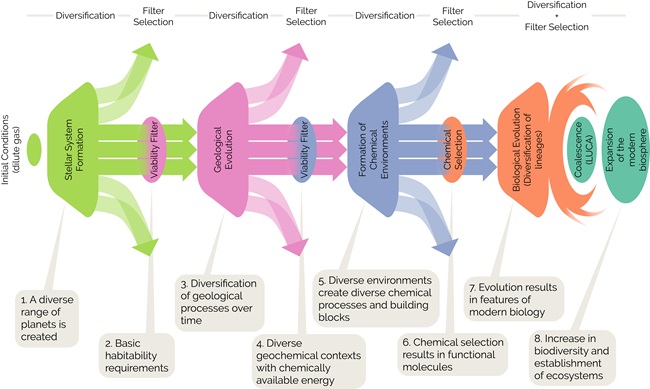
Called “the squid,” this diagram of a pathway from the formation of stellar systems to the emergence of life represents the ELSI model for the origins of life. The model is both a theoretical framework and a roadmap for origins of life research.
Back in the very earliest days of ELSI, the leaders of the institute promised to provide the World Premier International Research Center Initiative (WPI) with a model of what their science revealed about the emergence of life on Earth. That ELSI model has been discussed at length among ELSI scientists and evolved over time, and this year it was hammered out into words and a made into a diagram.
The result is not a description of the untold specific changes needed for life to arise from non-life, but rather a roadmap of those necessary metamorphoses reaching back from the formation of planets to the emergence of biology.
What follows are excerpts from a September Q & A with ELSI Executive Director Mary Voytek about the meaning, the value, and some of the implications of that origins-of-life roadmap:
Marc Kaufman: Please introduce us to the important themes and dynamics of the ELSI model of how life began on Earth.
Mary Voytek: What we produced is a philosophical model that allows us to place onto it everything we do, and that shows why the approaches of our many researchers make sense.
One consistent view that came out of our discussions of how life began is the notion of a series of expansions into the space of possibilities, with a series of gates that we identified based on what was needed on the other side. The best example I can describe – the most obvious to people – may be that all sorts of planets have been formed, but we need a planet with certain distinguishing features or else there never will be life. So the gateway becomes planetary habitability.
When the original ELSI proposal went in to the WPI, there was a promise that we would come out with our own model of the origins of life. Some people had the expectation that we would say it happened here, it happened this way and in this order. They had in mind a specific answer, or at least a potential scenario.
But that isn’t possible given what is knowable and what isn’t.
Instead, I do think that we have captured a mechanism that makes sense universally –what we know of our solar system and other solar systems. This would be a good model for both. The idea of expansion and selection can be applied very broadly. One is driven by the physics of what is possible, and the other is a filter that produces a subset that will actually lead to the next step.
Within this trajectory on Earth, fundamentally we see messy chemistry that leads to sloppy biology that eventually fixes itself into something that all other life evolves from. And none of this happens in isolation – that’s central to the model.
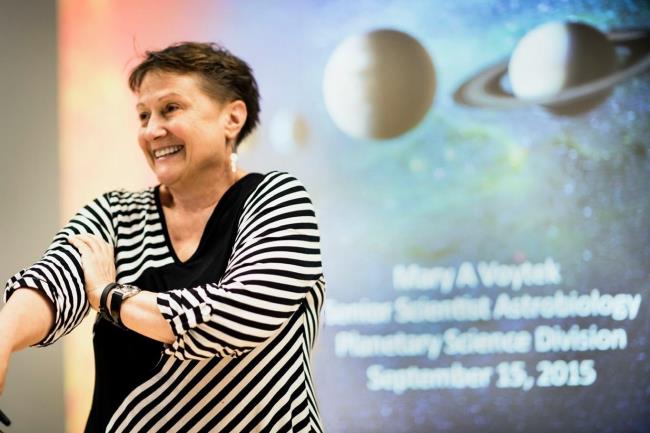
ELSI Executive Director Mary Voytek (Nerissa Escanlar)
MK: Is it possible to reach an understanding of how life began on Earth, or to find a specific scenario for how it began?
MV: Yes, it is possible to reach a general understanding about how life emerged. However, no matter what you come up with for a scenario, no matter how specific, you face these obstacles: first, you can’t prove most of the specifics, ever, unless you can figure out how to go back in time. There is no fossil record for many of these things we’re trying to reconstruct, so it will always be only a possible origin. There are likely many possible origin scenarios.
And second, the more prescriptive we get about a solution here on Earth, a solution that is based on what we have now in modern biology, the more likely it becomes that we may get it completely wrong. Because in the grand scheme of things, everything we see today has as its ancestor a particular lineage, and that lineage may not have been around at the very beginning. What is called LUCA – the Last Universal Common Ancestor – may have been modified significantly from any original biological entities before it actually gave birth to the modern biosphere.
People who see the origins of life through a particular model or scenarios can potentially ignore alternative possibilities and limit intellectual thought. Sometimes this can lead to such an investment in that scenario that everything has to be made to fit, even if it can’t be made to fit and shouldn’t be made to fit no matter how much hard work you put into it.
Our approach keeps us open. We don’t have to rejigger our scenario when new data come in because we don’t have a specific scenario to defend that depends on the new observation being a certain thing.
But progress in understanding the origins of life is not only possible, but moving ahead steadily. Sometimes it involves a new approach to the questions or an especially useful recognition. One example that came from early work at ELSI is that the key milestones in the origins of life can’t happen in the same place. Conditions needed for various chemical reactions are different. Some environments can stimulate something to happen, but also destroy other things. So it’s quite possible that some of the steps that led to life might have occurred in different environments at different times, and at different places around the world.

Chemistry researchers Yayoi Hongo, Yi Ruiqin, Jim Cleaves, and Masashi Aono in the ELSI Agora. (Nerissa Escanlar)
MK: How is the ELSI model different from other approaches to the origins of life question?
MV: For us, you learn more about the function that life was trying to accomplish when you realize there are other ways to get there. And in the end, they may be much simpler.
For instance, (ELSI principal investigator Irena Mamajanov’s) “messy chemistry” works with branched polymers that form naturally. While they are not as good as nucleic acids or some of the other scaffolding that we have now, like DNA or RNA, they still do provide a kind of scaffolding that can be easily made.
And then we start thinking, okay, there are lots of ways to make this scaffolding so we could have gotten to it through messy chemistry, and then what is the next step? How to make this scaffolding more specific, so it only acts in a particular way. And how to make a scaffolding that can be self-replicating.
Some colleagues who were trying to describe what we do put it like this: if I pointed you to a tray of French pastries and handed you a sack of mined salt, a chicken, a cow, and an old-fashioned machine, how would you know what to do? How do you know how to make French pastry with what you were given?
If you only look at the finished product, you won’t get very far – nothing would tell you how people learned to get milk or butter or cream from a cow, or how to raise chickens for their eggs, or how to make the batter rise.
We do something somewhat similar. We keep on going back to investigate what came before and what came after, what were the possible techniques and ingredients? What are the possible ways that our world could have turned out the way it did?
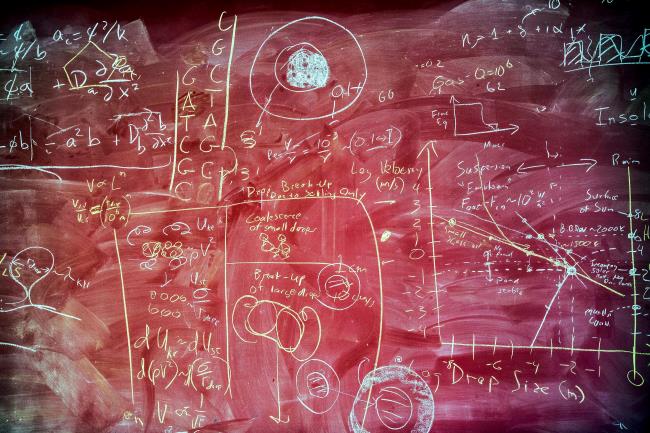
Graphs, equations, and formulations of all kinds find their way onto the chalkboards of the Agora. (Nerissa Escanlar)
MK: When we spoke early in the year, you described the ELSI model in terms of a series of hourglasses. Those forms are still there, but a lot has been added. What happened?
MV: I pushed for the squid to take in more of what we do here.
The concept was that the philosophical (hourglass) model is what ELSI uses. People work on expanding into the space of possibilities, and people work on the specifics of the gates.
The squid diagram is supposed to point out that we don’t always give up what we learned from an expansion just because it’s no longer needed to explain origins of life. It can inform the origin of our solar system or the origin of the Earth, and so that science doesn’t go away. But it’s not part of the trajectory to get to life.
For instance, once you find out there are hot Jupiters (gas giant exoplanets) you can still study hot Jupiters, but that may not help you understand the emergence of life because they can’t support life. The fact that they were created is important in terms of understanding planet formation and habitable planets. This is why the diagram has exit ramps that fall off the main path.
A modification to the diagram you can see was the recognition that, before LUCA, there could have been evolving lineages that went extinct: another exit ramp. With the techniques we currently have to evaluate early lineages, and the information from investigated modern lineages, we can’t predict what these might have been.
People like (Arizona State University cosmologist and astrobiologist) Paul Davies think about a “shadow biosphere” that might represent other unidentified lineages, but the way we sample our environment is such that we miss out on things that are rare. We also look for things based on what we understand about the winners.
And LUCA is the winning lineage; everything in the biosphere we know came from that. So we focus on what led to and enabled LUCA and, to some extent, what followed as biology expanded.
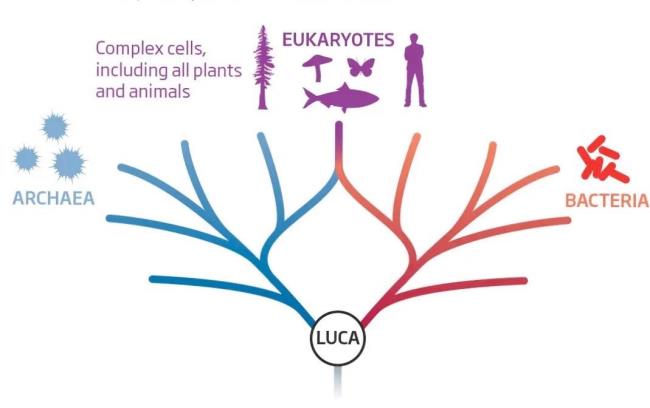
The Last Universal Common Ancestor is understood within ELSI to have been not a single cell, but an early population of cells that shared some traits and were diverse in others.
MK: The structure of the ELSI model diagram changes with the arrival of LUCA. Before that you show a process by which stars and planets form, chemicals and chemical processes diversify to form functional molecules, and then evolve into constructs with some features of modern biology. But LUCA is not connected to what came before it in the same direct way.
MV: At that stage chemistry shifts to biology. The earliest things that look like cells might be oil droplets or organic microspheres or some other phase-separating structure that formed the earliest examples of membranes. Metabolisms begin to evolve, though not necessarily associated with cells. Without cells, everything is dilute and messy. Cells make them more efficient. This is the step that allows sloppy systems to rise to the next level of structure and ultimately to biology as we now know it.
We think a wide variety of lineages reach this point, but many become extinct because they don’t move forward. In time we get to that last common ancestor population of cells. We don’t think LUCA is a single cell, but rather an early population of cells that shared some features but also exhibited diversity in some specifics.
They all had nucleic acids, peptides, enzymes, lipids, structure, cell walls, but maybe different cells had walls made of esters or simple lipids. These kind of differences then become available to draw on and expand into the modern biosphere. But you’ve already lost some options because they weren’t selectively competitive.
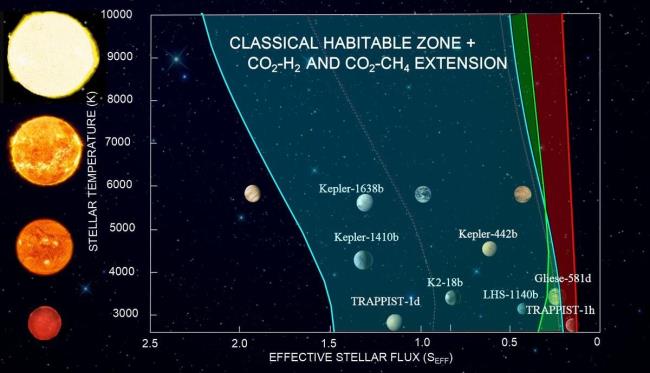
ELSI planetary scientist and astrobiologist Ramses Ramirez studies the nature and characteristics of the habitable zone – the region around a host star in which a planet might be able to support life. In a Geosciences paper he examined the “classical habitable zone” and some newer formulations. (Ramirez, Geosciences 2018.)
MK: Why does your research into the origins of life reach many billions of years back to the formation of stellar and solar systems?
MV: It starts with Carl Sagan who famously said that, to bake an apple pie from scratch, you must first invent the universe. There’s a strong understanding that everything we have now came into being and was set into motion at the time of the Big Bang.
The materials of life, the processes that happened – they were all necessary for what came next. In fact, this is why many of us think that it’s highly likely that life has evolved somewhere else too.
There’s nothing particularly special about Earth. A trajectory over billions of years has led to life here, and it could have happened in other places and galaxies.
------
Marc Kaufman has written books on astrobiology and Mars, has been a longtime reporter at The Washington Post and The Philadelphia Inquirer, and writes the NASA-supported online column Many Worlds (www.manyworlds.space) He has also had the good fortune to visit and work at ELSI numerous times and he wrote "ELSI RISING" -- the story of ELSI's origins and evolution -- in 2017.
